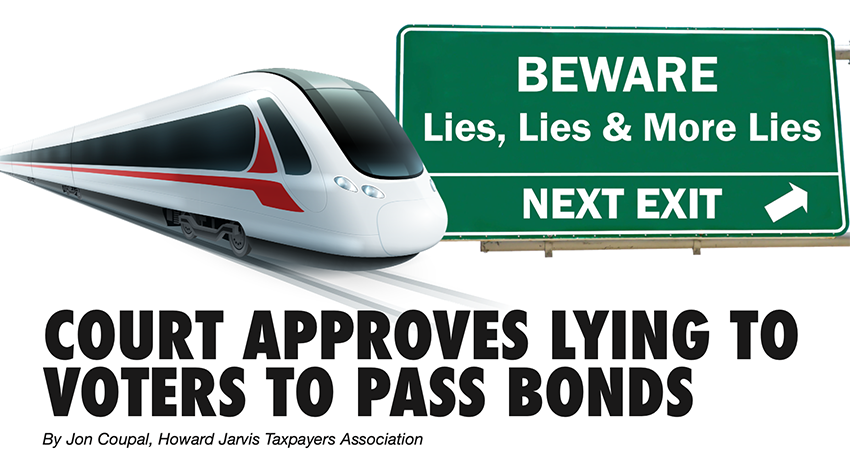Court Approves Lying to Voters to Pass Bonds

By Jon Coupal, Howard Jarvis Taxpayers Association
If ever voters needed a reason to vote no on every single bond measure that appears on the ballot, here it is: The Court of Appeal for Third Appellate District just ruled that, despite all the lies voters were told about California’s infamous High-Speed Rail project, taxpayers have no remedy, even though the project as it exists today bears no relation to what voters were told when they approved the $9.9 billion bond in 2008.
Californians were promised a super-fast train that would travel between Los Angeles and San Francisco in about two and a half hours; the ticket price would be about $50; the total cost of the high-speed rail would be about $40 billion; and there would be significant private-sector support –money from investors — to build the project.
Even before the 2008 vote, transportation experts were warning that the project would become a massive black hole into which California taxpayers would be committed to pouring hundreds of billions of dollars. In fact, a 2008 study sponsored by the Reason Foundation and the Howard Jarvis Taxpayers Foundation predicted that the promised total cost of $45 billion would quickly turn into $100 billion or more, stating that “There are no genuine financial projections that indicate there will be sufficient funds.” The only error in the study now appears that the dollar amount was too low.
The high speed rail project has been the target of multiple lawsuits, including a few that challenged the legality of the entire enterprise. But it now appears that the last legal roadblock to this continued wasting of taxpayer dollars has been removed. In Tos vs. State of California, the court ruled that even though nothing the voters were promised in 2008 could possibly become true, the bonds could now be sold to finance the project.
There is a disturbing message here for all California voters and taxpayers. When it comes to bond measures, nothing that is promised in the law authorizing the bond is worth the paper it is written on. If a bond act states that voter approval will authorize the construction of a high school, don’t be surprised if the revenue is later used for a prison. While that may be an extreme example, it is not beyond the realm of possibility.
Even more disappointing is the fact that whenever a state or local government spends bond funds for a project that deviates in substantive ways from what was described in the ballot material presented to the voters, there will be no legal remedy. The voters’ only option to prevent this bait-and-switch is to adopt a policy of blanket rejection of all bond measures.
The court’s ruling creates an even greater incentive for public entities to misrepresent what bond measures will accomplish. If they can secure initial voter approval, no judge in California is going to interfere once the project has started construction. This is the cynical playbook used by the High Speed Rail Authority, which followed Willie Brown’s advice. The former Assembly Speaker, in a moment of candor, once told the San Francisco Chronicle, “In the world of civic projects, the first budget is really just a down payment. If people knew the real cost from the start, nothing would ever be approved. The idea is to get going. Start digging a hole and make it so big, there’s no alternative to coming up with the money to fill it in.”
Unless state lawmakers have the courage to acknowledge, as did the State Auditor in 2018, that the project is unlikely ever to be completed as promised, the high-speed rail hole will only grow bigger. Since there’s no sign of that courage and no help from the courts, California is now stuck with what surely will be judged in the future as the largest waste of money in state history.
Jon Coupal is President of the Howard Jarvis Taxpayers Association. The opinions expressed in this article are those of its author and not necessarily those of the Apartment Association of Greater Los Angeles. This article is being reprinted with permission from the Howard Jarvis Taxpayer Association and the author.




